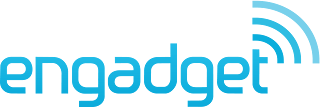Its been a while since my last post and things have been staying pretty busy here. So much so that there has not been to much time to do screen printed posters. There has been some screen printing but that is another post all together.
Tonight i'd like to share with you a project that i was working on back in Feb and March of this year. It all began back in the early part of December 2012. I got an email from the managing editor at Engadget,
Darren Murph. He was writing to see if i'd be interested in putting a proposal together for a conference that
Engadget were putting together. Needless to say i was over the moon to put together a proposal for them. There was quite a tight turn around time attached to this project. Roughly 2 weeks from start to finish to prepare the logo proposal and submit a final.
Here are a few of the roughs that were put together leading up to the final. You can see the progression of the mark and how it took shape.
I was trying to convey the how much technology changes. The more research i collected on engadget and what they do the more i realized that Expand(ing) was probably the best way to describe technology. Nothing seems to stay cutting edge very long. In the second image above i hinted at this with the "onward and upward" arrow as part of the X. The images beneath was simply to take the "power icon" and rotate it so that it read as a very stylized "E" or "e" (it really worked as both, I personally saw it as an uppcase that kept in line with the rest of the uppercase letters).
After some client feedback we ended up combining a few elements. Which i was more than happy to do after being inspired by an article written by Armin Vit, of
Under Consideration. It hit a nerve that i think more designers should really evaluate. You can read that
article in the archive of Under Consideration here.
The final submission to the board for review was to incorporate the arrows coming of all ends of the "X". This was added to the smoother dimensional text to create this mark below. In an effort to try creating a more original x with arrows i kept the on moving forward detached. This again nodded to our constant reach to grasp the stars.
I am pleased with how the logo plays to the parent brand of Engadget. This was part of the art direction that was given, "Needs to play nice with the existing Engadget brand".
Borrowing the blue color palette was the starting point. Carrying the rounded edges over was a subtlety that i felt needed to be passed down from the parent. One final detail that was decided upon was to keep the lowercase "e" of Engadge's logo intact. We did some iterations that tried to incorporate the "signal" element of the Engadget logo, but in the end were removed for simplification purposes.
There is plenty more to share with you about the conference that followed. It was held in San Francisco over March 16th-17th. Here is a
review that Engadget put out and some numbers to take a look at.
- Number of registered attendees: 1,965
- Number of speakers and panelists on stage: 52
- Number of stage sessions over two days: 24
- Cameras rolling on the stage: 7
- Number of exhibitors: 42
- Exhibition area in square feet: 50,000
- The battery-life of Boston Dynamics' BigDog on an experimental electric bike power pack: 8 minutes
- Feedback period on Lenovo's ThinkPad redesign prototypes: 18 months
- Lengthiest commute to Expand for an Engadget editor: 6,910 miles
- Number of Insert Coin finalists invited: 13
- Insert Coin: New Challengers grand prize total (awarded to Ziphius): $20,000 (plus $5,000 Reader's Choice prize)
- Number of products given away on-stage: 64
- Price of the MakerBot Replicator 2: $2,200
- Tweets covering Expand SF 2013: over 5,000
- Number of Engadget Expand posts during the event: 74
- Number of arcade machines at our opening-night party: 67
- Wager between Engadget Editor-in-chief Tim Stevens and Piper Jaffray's Gene Munster on that long-rumored Apple TV hardware appearing this year: $100
Thanks for stopping by more to come.









